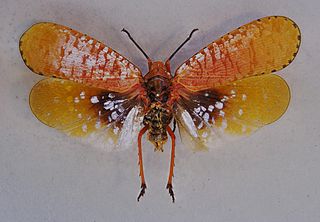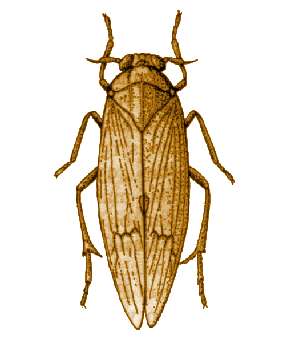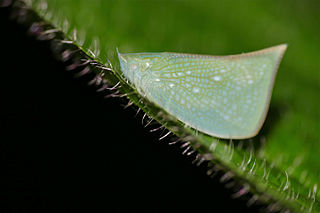
A planthopper is any insect in the infraorder Fulgoromorpha, in the suborder Auchenorrhyncha, a group exceeding 12,500 described species worldwide. The name comes from their remarkable resemblance to leaves and other plants of their environment and that they often "hop" for quick transportation in a similar way to that of grasshoppers. However, planthoppers generally walk very slowly. Distributed worldwide, all members of this group are plant-feeders, though few are considered pests. The infraorder contains two superfamilies, Fulgoroidea and Delphacoidea. Fulgoroids are most reliably distinguished from the other Auchenorrhyncha by two features; the bifurcate (Y-shaped) anal vein in the forewing, and the thickened, three-segmented antennae, with a generally round or egg-shaped second segment (pedicel) that bears a fine filamentous arista.

Delphacidae is a family of planthoppers containing about 2000 species, distributed worldwide. Delphacids are separated from other "hoppers" by the prominent spur on the tibia of the hindleg.

Ricaniidae is a family of planthopper insects, containing over 400 species worldwide. The highest diversity is in tropical Africa and Asia and in Australia, with a few species occurring in the Palearctic and Neotropical realms. It is one of the smaller families in the planthopper superfamily Fulgoroidea.

Flatidae are a family of fulgoroid planthoppers. They are cosmopolitan in distribution and are distinguished from others in the superfamily by a combination of characters. Like all other planthoppers, they suck phloem sap of plants. Some species are known to communicate with vibrations through the plant stems. Communication may be with mates, or with ants that tend the nymphs, protecting them and gathering honeydew secretions. Adults of some species have brightly coloured forewings which are tougher and known as tegmina unlike the membranous hindwings which are used for flight. Although a few can be identified by their coloration, most species requires dissection and examination under a microscope with access to literature on already described species.

Issidae is a family of planthoppers described by Spinola in 1839, belonging to the order Hemiptera, suborder Auchenorrhyncha superfamily Fulgoroidea.

Nogodinidae is a family of planthoppers. They have membranous wings with delicate venation and can be confused with members of other Fulgoroid families such as the Issidae and Tropiduchidae. Some authors treat it as a subfamily of the Issidae.

Gergithus is a genus of tropical Asian planthoppers in the family Issidae, erected by Carl Stål in 1870. Like all planthoppers, adults feed on plant sap and are capable of escaping by leaping. The genus like other members in the tribe appears somewhat rounded and beetle-like, in some cases, with a mimetic resemblance to ladybird beetles. Species are mostly distributed in the Indomalayan Realm.
The Elicini are a tribe of planthoppers in the family Tropiduchidae. The type genus is Elica.

Achilidae is a family of planthoppers, sometimes called "achilids" in the order Hemiptera. There are at least 520 described species in Achilidae.

Aphaena is a genus of planthoppers in the sub-family Aphaeninae of Fulgoridae. Species are distributed from eastern India, Indo-China, China and Malesia.

Nilaparvata is a genus of planthoppers in the subfamily Delphacinae and tribe Delphacini Leach, 1815.

The Flatinae are a subfamily of planthoppers, erected by Maximilian Spinola in 1839. Genera have been recorded from all continents except Antarctica: especially in tropical and subtropical regions.
Tropidocephala is a genus of planthopper bugs, typical of the tribe Tropidocephalini. Species have been recorded from Africa, Europe and Asia.
Tropiduchus is a genus of planthoppers, recorded from Africa and Malesia.

The Menoscinae are a subfamily of planthoppers in the family Lophopidae erected by Leopold Melichar in 1915. Most genera are recorded from SE Asia through to Australia, but the single genus in tribe Carrioniini is Neotropical.

Lawana is a genus of planthoppers in the family Flatidae, erected by William Lucas Distant in 1906. In 1923, Leopold Melichar confirmed placement of this genus in tribe Flatini and subtribe Lawanina. Species are recorded from tropical Africa and Asia.
Flata is the type genus of planthoppers in the family Flatidae and tribe Flatini, erected by Johan Christian Fabricius in 1798. Species are recorded from subtropical and tropical Asia including India, China, Indochina and Malesia.
Neosalurnis is a genus of planthoppers in the family Flatidae, erected by William Lucas Distant in 1910. It was subsequently placed in tribe Flatini, subtribe Phyllyphantina by Metcalf (1957) Records of occurrence are currently from Vietnam and China.

The Plectoderini are a large tribe of planthoppers in the family Achilidae, erected by Ronald Gordon Fennah in 1950. Genera have a world-wide distribution, but are hardly represented in Europe or northern Asia.
Mnemosyne is a genus of planthoppers in the subfamily Cixiinae, erected by Carl Stål in 1866; it is the only extant type genus of the tribe Mnemosynini. Species are recorded from: South America, Africa, the Indian subcontinent, SE Asia and Australia.













